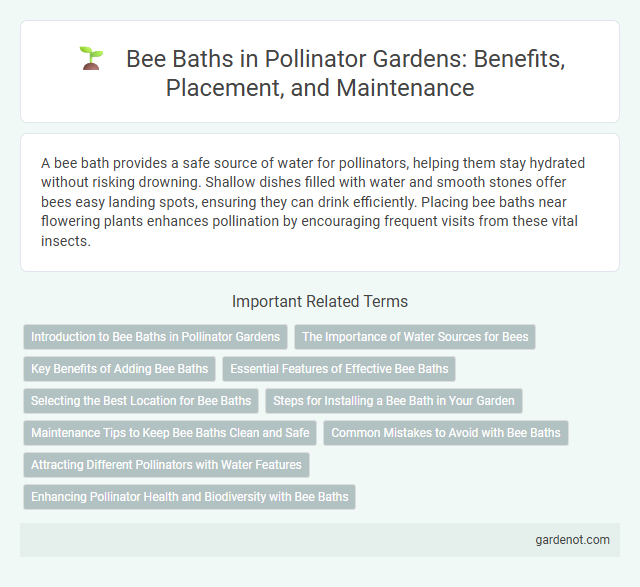A bee bath provides a safe source of water for pollinators, helping them stay hydrated without risking drowning. Shallow dishes filled with water and smooth stones offer bees easy landing spots, ensuring they can drink efficiently. Placing bee baths near flowering plants enhances pollination by encouraging frequent visits from these vital insects.
Introduction to Bee Baths in Pollinator Gardens
Bee baths provide essential water sources for pollinators, helping maintain hydration during hot, dry periods. Designed with shallow basins and gentle slopes, bee baths prevent drowning and attract various bee species to the garden. Incorporating these features enhances pollinator health and supports biodiversity in pollinator-friendly gardens.
The Importance of Water Sources for Bees
Bee baths provide essential water sources that support the hydration and thermoregulation of pollinators like honeybees, bumblebees, and solitary bees. Access to clean, shallow water prevents dehydration and helps bees maintain hive temperature during hot weather, enhancing their foraging efficiency. Incorporating bee baths into pollinator gardens promotes biodiversity and strengthens local ecosystems by sustaining healthy bee populations.
Key Benefits of Adding Bee Baths
Bee baths provide essential water sources that help maintain healthy bee populations by preventing dehydration. These shallow water features attract various pollinators, enhancing garden biodiversity and promoting effective pollination. Incorporating bee baths supports ecosystem balance and boosts the productivity of flowering plants and crops.
Essential Features of Effective Bee Baths
Effective bee baths include shallow water with gentle slopes or floating platforms to prevent drowning, and small stones or twigs for bees to land on safely. Clean, fresh water free from chemicals and pesticides is crucial to attract and protect pollinators. Placing bee baths in shaded, sheltered locations enhances usability and encourages frequent visitation by native bee species.
Selecting the Best Location for Bee Baths
Choosing the ideal location for a bee bath involves placing it in a sunny, sheltered spot that remains free from strong winds and predators. Position the bath near flowering plants to provide easy access to water and nectar, enhancing bee activity and health. Ensure the water source is shallow with safe landing spots, reducing the risk of drowning while supporting diverse pollinator species.
Steps for Installing a Bee Bath in Your Garden
Installing a bee bath in your garden requires selecting a shallow, sturdy container filled with clean water and smooth stones or marbles for bees to land safely. Position the bee bath in a sunny, sheltered spot near flowering plants to attract pollinators and ensure the water is changed regularly to prevent stagnation. Incorporating native plants and avoiding pesticides around the bee bath will promote a healthy environment for bees and other pollinators.
Maintenance Tips to Keep Bee Baths Clean and Safe
Regularly change the water in bee baths every two to three days to prevent mosquito breeding and bacterial growth. Use smooth stones or floating materials to provide safe landing spots for bees, avoiding drowned insects. Clean the bath with a mild vinegar solution weekly to remove algae and debris, ensuring a safe environment for pollinators.
Common Mistakes to Avoid with Bee Baths
Placing bee baths with deep water can cause drowning, so shallow water with pebbles or floating materials is essential for bee safety. Avoid stagnant water by regularly refreshing it to prevent mosquito breeding and maintain cleanliness. Position the bath in a sunny, sheltered spot away from strong winds to encourage frequent bee visits.
Attracting Different Pollinators with Water Features
Incorporating a bee bath into a pollinator garden provides essential hydration for various pollinators, including bees, butterflies, and hummingbirds, enhancing biodiversity. Shallow water features with smooth stones or floating platforms attract different species by offering safe landing spots and clean drinking water. Proper placement near native flowering plants maximizes pollinator visits and supports ecosystem health.
Enhancing Pollinator Health and Biodiversity with Bee Baths
Bee baths provide essential water sources that support pollinator health by preventing dehydration and reducing stress in various bee species. These shallow water features, often filled with pebbles or twigs, offer safe landing spots for bees, enhancing their foraging efficiency and overall wellness. Incorporating bee baths into pollinator gardens boosts biodiversity by sustaining diverse pollinator populations critical for ecosystem balance and crop pollination.
Bee bath Infographic

 gardenot.com
gardenot.com